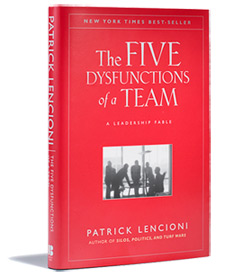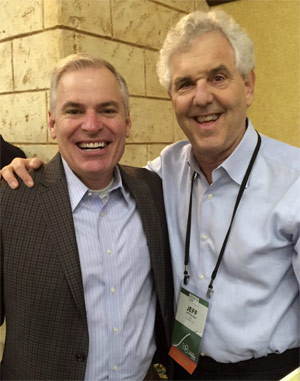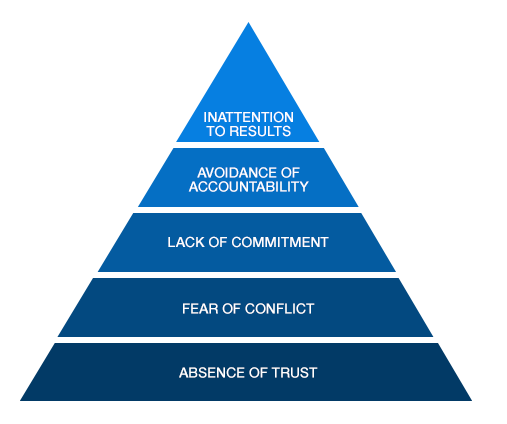Building High Performing Leadership Teams
A “healthy” leadership team is critical for a company to grow and scale. Great teams don’t just happen and individuals don’t just come together automatically to accomplish outstanding results. Authentic teamwork is built upon true commitment, trust, collaboration, and competence – qualities that can only be developed with considerable sacrifice and effort over time.
 Our 4-day team building program (two, 2-day sessions spaced 90 days apart) provides in-depth skill development and tools in the vital areas needed for effective performance (programs are also available in 2-day and 1-day formats). Adapting the pyramid model of Patrick Lencioni’s Five Dysfunctions of a Team, these areas include giving and receiving feedback, managing conflict, decision making, building trust, improving meetings, and creating accountability and commitment. Teams emerge from the learning experience with a fresh sense of direction and practical strategies for working together to achieve greater results.
Our 4-day team building program (two, 2-day sessions spaced 90 days apart) provides in-depth skill development and tools in the vital areas needed for effective performance (programs are also available in 2-day and 1-day formats). Adapting the pyramid model of Patrick Lencioni’s Five Dysfunctions of a Team, these areas include giving and receiving feedback, managing conflict, decision making, building trust, improving meetings, and creating accountability and commitment. Teams emerge from the learning experience with a fresh sense of direction and practical strategies for working together to achieve greater results.
Team Challenges we will address:
- Effective communication between the leader and team members, and among team members themselves
- Improved team decision-making
- Clarity and commitment to team goals
- Managing accountability by utilizing feedback models and processes
- Stronger and more trusting relationships among team members
- Effective dialogue and managing individual and team conflicts
- Reduced barriers between functional silos/departments – improved collaboration across boundaries
- Improving the quality of meetings, passionate debate and decision making
- Development of team norms

The Teambuilding Model

JDA utilizes the pyramid model popularized by Patrick Lencioni in the book The Five Dysfunctions of a Team.

We design and customize our teambuilding process around:
- Building Trust
Members of great teams trust one another on a fundamental, emotional level, and they are comfortable being vulnerable with each other about their weaknesses, mistakes, fears and behaviors. They get to a point where they can be completely open with one another, without filters. This is essential because… - Mastering Conflict
Teams that trust one another are not afraid to engage in passionate dialogue around issues and decisions that are key to the organization’s success. They do not hesitate to disagree with, challenge, and question one another, all in the spirit of finding the best answers, discovering the truth, and making great decisions. This is important because… - Achieving Commitment
Teams that engage in unfiltered conflict are able to achieve genuine buy-in around important decisions, even when various members of the team initially disagree. That’s because they ensure that all opinions and ideas are put on the table and considered, giving confidence to team members that no stone has been left unturned. This is critical because… - Embracing Accountability
Teams that commit to decisions and standards of performance do not hesitate to hold one another accountable for adhering to those decisions and standards. What is more, they don’t rely on the team leader as the primary source of accountability; they go directly to their peers. This matters because… - Focusing on Results
Teams that trust one another, engage in conflict, commit to decisions and hold one another accountable are very likely to set aside their individual needs and agendas and focus almost exclusively on what is best for the team. They do not give in to the temptation to place their departments, career aspirations or ego-driven status ahead of the collective results that define team success.
While we believe teambuilding experiences (such as ropes courses and games) have their place, our focus is on teaching team process and team skills, the building blocks of high performance teams.
© Patrick Lencioni, The Five Dysfunctions of a Team
What You Can Expect with JDA’s Teambuilding Process
PREWORK FOR EVERY SESSION
- Team Climate survey (all team members interviewed)
- 5-Dysfunction team assessment
- Individual SOCIAL STYLE profiles
- Team members receive and read “The Five Dysfunctions of a Team” prior to the session
PROGRAM OVERVIEW
- Assessment and Data Collection
Our consultant will conduct team climate interviews with each team member by phone. As part of the assessment process, team members will also participate in a 5-Dysfunction 360-team assessment survey. - Data Analysis and Program Design
Once we’ve analyzed the trends from our data collection, we:- Produce a detailed summary report that outlines the strengths and challenges of the team.
- Identify key leverage points and critical areas that must be addressed in order for the team to perform at a higher level.
- Make recommendations regarding the content and agenda for the team-building sessions.
The data from both assessments will be analyzed and reviewed first with you, and then with the team at the initial teambuilding session. - Delivery of Team Building Sessions
Team members participate in a two, 2-day sessions (spaced approximately 90 days apart) that targets the areas identified in the analysis as well as taking them through the five fundamentals that build highly effective teams. - Evaluation and Follow-up
Follow-up activities include additional team-building sessions, skill training workshops, and/or executive coaching for key individuals, depending on the need.
